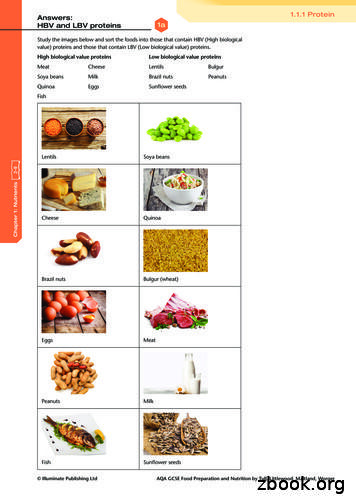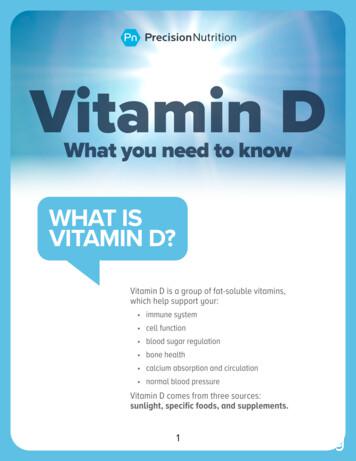Vitamin And Mineral Requirements In Human Nutrition
Vitamin and mineralrequirementsin human nutritionSecond edition
WHO Library Cataloguing-in-Publication DataJoint FAO/WHO Expert Consultation on Human Vitamin and Mineral Requirements(1998 : Bangkok, Thailand).Vitamin and mineral requirements in human nutrition : report of a joint FAO/WHO expertconsultation, Bangkok, Thailand, 21–30 September 1998.1.Vitamins — standards 2.Micronutrients — standards 3.Trace elements — standards4.Deficiency diseases — diet therapy 5.Nutritional requirements I.Title.ISBN 92 4 154612 3(LC/NLM Classification: QU 145) World Health Organization and Food and Agriculture Organization of the United Nations2004All rights reserved. Publications of the World Health Organization can be obtained from Marketing and Dissemination, World Health Organization, 20 Avenue Appia, 1211 Geneva 27, Switzerland(tel: 41 22 791 2476; fax: 41 22 791 4857; e-mail: bookorders@who.int). Requests for permission to reproduce or translate WHO publications — whether for sale or for noncommercial distribution — should be addressed to Publications, at the above address (fax: 41 22 791 4806; e-mail:permissions@who.int), or to Chief, Publishing and Multimedia Service, Information Division, Foodand Agriculture Organization of the United Nations, 00100 Rome, Italy.The designations employed and the presentation of the material in this publication do not implythe expression of any opinion whatsoever on the part of the World Health Organization and theFood and Agriculture Organization of the United Nations concerning the legal status of anycountry, territory, city or area or of its authorities, or concerning the delimitation of its frontiersor boundaries. Dotted lines on maps represent approximate border lines for which there may notyet be full agreement.The mention of specific companies or of certain manufacturers’ products does not imply that theyare endorsed or recommended by the World Health Organization and the Food and AgricultureOrganization of the United Nations in preference to others of a similar nature that are not mentioned. Errors and omissions excepted, the names of proprietary products are distinguished byinitial capital letters.The World Health Organization and the Food and Agriculture Organization of the United Nationsdo not warrant that the information contained in this publication is complete and correct andshall not be liable for any damages incurred as a result of its use.Designed by minimum graphicsTypeset by SNP Best-set Typesetter Ltd., Hong KongPrinted in China by Sun Fung
ContentsForewordAcknowledgementsxiiixvii1. Concepts, definitions and approaches used to define nutritionalneeds and recommendations1.1 Introduction1.2 Definition of terms1.2.1 Estimated average requirement1.2.2 Recommended nutrient intake1.2.3 Apparently healthy1.2.4 Protective nutrient intake1.2.5 Upper tolerable nutrient intake level1.2.6 Nutrient excess1.2.7 Use of nutrient intake recommendations in populationassessment1.3 Approaches used in estimating nutrient intakes for optimalhealth1.3.1 The clinical approach1.3.2 Nutrient balance1.3.3 Functional responses1.3.4 Optimal intake1.4 ConclusionsReferences2. Vitamin A2.1 Role of vitamin A in human metabolic processes2.1.1 Overview of vitamin A metabolism2.1.2 Biochemical mechanisms for vitamin A functions2.2 Populations at risk for, and consequences of, vitamin Adeficiency2.2.1 Definition of vitamin A deficiency2.2.2 Geographic distribution and magnitude2.2.3 Age and sexiii112223344568891012141717171920202021
VITAMIN AND MINERAL REQUIREMENTS IN HUMAN NUTRITION2.2.4 Risk factors2.2.5 Morbidity and mortality2.3 Units of expression2.4 Sources and supply patterns of vitamin A2.4.1 Dietary sources2.4.2 Dietary intake and patterns2.4.3 World and regional supply and patterns2.5 Indicators of vitamin A deficiency2.5.1 Clinical indicators of vitamin A deficiency2.5.2 Subclinical indicators of vitamin A deficiency2.6 Evidence used for making recommendations2.6.1 Infants and children2.6.2 Adults2.6.3 Pregnant women2.6.4 Lactating women2.6.5 Elderly2.7 Recommendations for vitamin A requirements2.8 Toxicity2.9 Recommendations for future 353637373. Vitamin D3.1 Role of vitamin D in human metabolic processes3.1.1 Overview of vitamin D metabolism3.1.2 Calcium homeostasis3.2 Populations at risk for vitamin D deficiency3.2.1 Infants3.2.2 Adolescents3.2.3 Elderly3.2.4 Pregnant and lactating women3.3 Evidence used for estimating recommended intakes3.3.1 Lack of accuracy in estimating dietary intake and skinsynthesis3.3.2 Use of plasma 25-OH-D as a measure of vitamin Dstatus3.4 Recommended intakes for vitamin D3.5 Toxicity3.6 Recommendations for future researchReferences454545464848484849514. Calcium4.1 Introduction4.2 Chemistry and distribution of calcium595960iv515153545555
CONTENTS4.34.4Biological role of calciumDeterminants of calcium balance4.4.1 Calcium intake4.4.2 Calcium absorption4.4.3 Urinary calcium4.4.4 Insensible losses4.5 Criteria for assessing calcium requirements andrecommended nutrient intakes4.5.1 Methodology4.5.2 Populations at risk for calcium deficiency4.6 Recommendations for calcium requirements4.6.1 Infants4.6.2 Children4.6.3 Adolescents4.6.4 Adults4.6.5 Menopausal women4.6.6 Ageing adults4.6.7 Pregnant women4.6.8 Lactating women4.7 Upper limits4.8 Comparisons with other recommendations4.9 Ethnic and environmental variations in the prevalence ofosteoporosis4.9.1 Ethnicity4.9.2 Geography4.9.3 Culture and diet4.9.4 The calcium paradox4.10 Nutritional factors affecting calcium requirement4.10.1 Sodium4.10.2 Protein4.10.3 Vitamin D4.10.4 Implications4.11 Conclusions4.12 Recommendations for future researchReferences757676777878787981818385855. Vitamin E5.1 Role of vitamin E in human metabolic processes5.2 Populations at risk for vitamin E deficiency5.3 Dietary sources and possible limitations to vitamin E supply5.4 Evidence used for estimating recommended intakes5.5 72727373737474
VITAMIN AND MINERAL REQUIREMENTS IN HUMAN NUTRITION5.6 Recommendations for future researchReferences1031046. Vitamin K6.1 Introduction6.2 Biological role of vitamin K6.3 Overview of vitamin K metabolism6.3.1 Absorption and transport6.3.2 Tissue stores and distribution6.3.3 Bioactivity6.3.4 Excretion6.4 Populations at risk for vitamin K deficiency6.4.1 Vitamin K deficiency bleeding in infants6.4.2 Vitamin K prophylaxis in infants6.4.3 Vitamin K deficiency in adults6.5 Sources of vitamin K6.5.1 Dietary sources6.5.2 Bioavailability of vitamin K from foods6.5.3 Importance of intestinal bacterial synthesis asa source of vitamin K6.6 Information relevant to the derivation of recommendedvitamin K intakes6.6.1 Assessment of vitamin K status6.6.2 Dietary intakes in infants and their adequacy6.6.3 Factors of relevance to classical vitamin K deficiencybleeding6.6.4 Factors of relevance to late vitamin K deficiencybleeding6.6.5 Dietary intakes in older infants, children, and adultsand their adequacy6.7 Recommendations for vitamin K intakes6.7.1 Infants 0–6 months6.7.2 Infants (7–12 months), children, and adults6.8 Toxicity6.9 Recommendations for future researchReferences1201221221251261261267. Vitamin C7.1 Introduction7.2 Role of vitamin C in human metabolic processes7.2.1 Background biochemistry7.2.2 Enzymatic 113113114115115115116117117117118119120
CONTENTS7.2.3 Miscellaneous functionsConsequences of vitamin C deficiencyPopulations at risk for vitamin C deficiencyDietary sources of vitamin C and limitations to vitamin Csupply7.6 Evidence used to derive recommended intakes of vitamin C7.6.1 Adults7.6.2 Pregnant and lactating women7.6.3 Children7.6.4 Elderly7.6.5 Smokers7.7 Recommended nutrient intakes for vitamin C7.8 Toxicity7.9 Recommendations for future 98. Dietary antioxidants8.1 Nutrients with an antioxidant role8.2 The need for biological antioxidants8.3 Pro-oxidant activity of biological antioxidants8.4 Nutrients associated with endogenous antioxidant mechanisms8.5 Nutrients with radical-quenching properties8.5.1 Vitamin E8.5.2 Vitamin C8.5.3 b-Carotene and other carotenoids8.6 A requirement for antioxidant nutrients8.7 Recommendations for future 81589. Thiamine, riboflavin, niacin, vitamin B6, pantothenic acid,and biotin9.1 Introduction9.2 Thiamine9.2.1 Background9.2.2 Biochemical indicators9.2.3 Factors affecting requirements9.2.4 Evidence used to derive recommended intakes9.2.5 Recommended nutrient intakes for thiamine9.3 Riboflavin9.3.1 Background9.3.2 Biochemical indicators9.3.3 Factors affecting 37.47.5vii131131132
VITAMIN AND MINERAL REQUIREMENTS IN HUMAN NUTRITION9.3.4 Evidence used to derive recommended intakes9.3.5 Recommended nutrient intakes for riboflavin9.4 Niacin9.4.1 Background9.4.2 Biochemical indicators9.4.3 Factors affecting requirements9.4.4 Evidence used to derive recommended intakes9.4.5 Recommended nutrient intakes for niacin9.5 Vitamin B69.5.1 Background9.5.2 Biochemical indicators9.5.3 Factors affecting requirements9.5.4 Evidence used to derive recommended intakes9.5.5 Recommended nutrient intakes for vitamin B69.6 Pantothenate9.6.1 Background9.6.2 Biochemical indicators9.6.3 Factors affecting requirements9.6.4 Evidence used to derive recommended intakes9.6.5 Recommended nutrient intakes for pantothenic acid9.7 Biotin9.7.1 Background9.7.2 Biochemical indicators9.7.3 Evidence used to derive recommended intakes9.7.4 Recommended nutrient intakes for biotin9.8 General considerations for B-complex vitamins9.8.1 Notes on suggested recommendations9.8.2 Dietary sources of B-complex vitamins9.9 Recommendations for future researchReferences10. Selenium10.1 Role of selenium in human metabolic processes10.2 Selenium deficiency10.2.1 Non-endemic deficiencies of selenium10.2.2 Keshan disease10.2.3 Kaschin-Beck disease10.2.4 Selenium status and susceptibility to infection10.2.5 Selenium and thyroid hormones10.3 The influence of diet on selenium status10.4 Absorption and bioavailability10.5 Criteria for assessing selenium 185186194194196196197198198200200204204
CONTENTS10.6Recommended selenium intakes10.6.1 Adults10.6.2 Infants10.6.3 Pregnant and lactating women10.7 Upper limits10.8 Comparison with other estimates10.9 Recommendations for future researchReferences11. Magnesium11.1 Tissue distribution and biological role of magnesium11.2 Populations at risk for, and consequences of,magnesium deficiency11.3 Dietary sources, absorption, and excretion of magnesium11.4 Criteria for assessing magnesium requirements and allowances11.5 Recommended intakes for magnesium11.6 Upper limits11.7 Comparison with other estimates11.8 Recommendations for future researchReferences12. Zinc12.112.212.312.412.5Role of zinc in human metabolic processesZinc metabolism and homeostasisDietary sources and bioavailability of zincPopulations at risk for zinc deficiencyEvidence used to estimate zinc requirements12.5.1 Infants, children, and adolescents12.5.2 Pregnant women12.5.3 Lactating women12.5.4 Elderly12.6 Interindividual variations in zinc requirements andrecommended nutrient intakes12.7 Upper limits12.8 Adequacy of zinc intakes in relation to requirement estimates12.9 Recommendations for future researchReferences13. Iron13.1 Role of iron in human metabolic processes13.2 Iron metabolism and absorption13.2.1 Basal iron losses13.2.2 Requirements for 1242243246246246246247
VITAMIN AND MINERAL REQUIREMENTS IN HUMAN NUTRITION13.2.3 Menstrual iron losses13.2.4 Iron absorption13.2.5 Inhibition of iron absorption13.2.6 Enhancement of iron absorption13.2.7 Iron absorption from meals13.2.8 Iron absorption from the whole diet13.2.9 Iron balance and regulation of iron absorption13.3 Iron deficiency13.3.1 Populations at risk for iron deficiency13.3.2 Indicators of iron deficiency13.3.3 Causes of iron deficiency13.3.4 Prevalence of iron deficiency13.3.5 Effects of iron deficiency13.4 Iron requirements during pregnancy and lactation13.5 Iron supplementation and fortification13.6 Evidence used for estimating recommended nutrient intakes13.7 Recommendations for iron intakes13.8 Recommendations for future 126226326426726827127227214. Vitamin B1214.1 Role of vitamin B12 in human metabolic processes14.2 Dietary sources and availability14.3 Absorption14.4 Populations at risk for, and consequences of, vitamin B12deficiency14.4.1 Vegetarians14.4.2 Pernicious anaemia14.4.3 Atrophic gastritis14.5 Vitamin B12 interaction with folate or folic acid14.6 Criteria for assessing vitamin B12 status14.7 Recommendations for vitamin B12 intakes14.7.1 Infants14.7.2 Children14.7.3 Adults14.7.4 Pregnant women14.7.5 Lactating women14.8 Upper limits14.9 Recommendations for future 628628628728715. Folate and folic acid15.1 Role of folate and folic acid in human metabolic processes289289x279279279280
CONTENTS15.215.315.415.5Populations at risk for folate deficiencyDietary sources of folateRecommended nutrient intakes for folateDifferences in bioavailability of folic acid and food folate:implications for the recommended intakes15.6 Considerations in viewing recommended intakes for folate15.6.1 Neural tube defects15.6.2 Cardiovascular disease15.6.3 Colorectal cancer15.7 Upper limits15.8 Recommendations for future 016. Iodine16.1 Role of iodine in human metabolic processes16.2 Populations at risk for iodine deficiency16.3 Dietary sources of iodine16.4 Recommended intakes for iodine16.4.1 Infants16.4.2 Children16.4.3 Adults16.4.4 Pregnant women16.5 Upper limits16.5.1 Iodine intake in areas of moderate iodine deficiency16.5.2 Iodine intake in areas of iodine sufficiency16.5.3 Excess iodine 1331431517. Food as a source of nutrients17.1 Importance of defining food-based recommendations17.2 Dietary diversification when consuming cereal- andtuber-based diets17.2.1 Vitamin A17.2.2 Vitamin C17.2.3 Folate17.2.4 Iron and zinc17.3 How to accomplish dietary diversity in practice17.4 Practices which will enhance the success of food-basedapproaches17.5 Delineating the role of supplementation and food fortificationfor micronutrients which cannot be supplied by food17.5.1 Fortification318318xi325325325326326327328329330
VITAMIN AND MINERAL REQUIREMENTS IN HUMAN NUTRITION17.5.2 Supplementation17.6 Food-based dietary guidelines17.7 Recommendations for the future17.8 Future research needsReferencesAnnex 1: Recommended nutrient intakes – mineralsAnnex 2: Recommended nutrient intakes – water- and fat-solublevitaminsxii332333335335336338340
ForewordIn the past 20 years, micronutrients have assumed great public health importance. As a consequence, considerable research has been carried out tobetter understand their physiological role and the health consequences ofmicronutrient-deficient diets, to establish criteria for defining the degree ofpublic health severity of micronutrient malnutrition, and to develop prevention and control strategies.One of the main outcomes of this process is greatly improved knowledgeof human micronutrient requirements, which is a crucial step in understanding the public health significance of micronutrient malnutrition and identifying the most appropriate measures to prevent them. This process also led tosuccessive expert consultations and publications organized jointly by theFood and Agriculture Organization of the United Nations (FAO), the WorldHealth Organization (WHO) and the International Atomic Energy Agency(IAEA) providing up-to-date knowledge and defining standards for micronutrient requirements in 19731, 19882 and in 19963. In recognition of this rapidlydeveloping field, and the substantial new advances that have been made sincethe most recent publication in 1996, FAO and WHO considered it appropriate to convene a new expert consultation to re-evaluate the role of micronutrients in human health and nutrition.To this end, background papers on the major vitamins, minerals and traceelements were commissioned and reviewed at a Joint FAO/WHO ExpertConsultation (Bangkok, 21–30 September 1998). That Expert Consultationwas assigned three main tasks: Firstly, the Consultation was asked to review the full range of vitamin andmineral requirements—19 micronutrients in all—including their role in123Trace elements in human nutrition. Report of a WHO Expert Committee. Geneva, WorldHealth Organization, 1973 (WHO Technical Report Series, No. 532).Requirements of vitamin A, iron, folate and vitamin B12. Report of a Joint FAO/WHOExpert Consultation. Rome, Food and Agriculture Organization of the United Nations,1988 (FAO Food and Nutrition Series, No. 23).Trace elements in human nutrition and health. Geneva, World Health Organization, 1996.xiii
VITAMIN AND MINERAL REQUIREMENTS IN HUMAN NUTRITIONnormal human physiology and metabolism, and conditions of deficiency.This included focusing on and revising the requirements for essential vitamins and minerals, including vitamins A, C, D, E, and K; the B vitamins;calcium; iron; magnesium; zinc; selenium; and iodine, based on the available scientific evidence. Secondly, the Consultation was asked to prepare a report that wouldinclude recommended nutrient intakes for vitamins A, C, D, E, and K; theB vitamins; calcium; iron; magnesium; zinc; selenium; and iodine. Thereport should provide practical advice and recommendations which willconstitute an authoritative source of information to all those from MemberStates who work in the areas of nutrition, agriculture, food production anddistribution, and health promotion. Thirdly, the Consultation was asked to identify key issues for futureresearch concerning each vitamin and mineral under review and to makepreliminary recommendations on that research.The present report presents the outcome of the Consultation combinedwith up-to-date evidence that has since become available to answer a numberof issues which remained unclear or controversial at the time of the Consultation. It was not originally thought that such an evidence-based consultationprocess would be so controversial, but the reality is that there are surprisinglyfew data on specific health status indicators on which to base conclusions,whereas there is a great deal of information relative to overt deficiency diseaseconditions. The defining of human nutrient requirements and recommendedintakes are therefore largely based on expert interpretation and consensus onthe best available scientific information.When looking at recommended nutrient intakes (RNIs) in industrializedcountries over the last 25 years, it is noticeable that for some micronutrientsthese have gradually increased. The question is whether this is the result ofbetter scientific knowledge and understanding of the biochemical role of thenutrients, or whether the criteria for setting requirement levels have changed,or a combination of both. The scientific knowledge base has vastly expanded,but it appears that more rigorous criteria for defining recommended levels isalso a key factor.RNIs for vitamins and minerals were initially established on the understanding that they are meant to meet the basic nutritional needs of over 97%of the population. However, a fundamental criterion in industrialized countries has become one of the presumptive role that these nutrients play in “preventing” an increasing range of disease conditions that characterize affectedpopulations. The latter approach implies trying to define the notion of
2.5.1 Clinical indicators of vitamin A deficiency 29 2.5.2 Subclinical indicators of vitamin A deficiency 30 2.6 Evidence used for making recommendations 31 2.6.1 Infants and children 32 2.6.2 Adults 33 2.6.3 Pregnant women 33 2.6.4 Lactating women 34 2.6.5 Elderly 35 2.7 Recommendations for vitamin A requirements 35 2.8 Toxicity 36 2.9 Recommendations for future research 37 References 37 3 .
Konsumsi asam folat, vitamin B12 dan vitamin C pada ibu hamil tergolong masih rendah, sehingga konsumsi sumber vitamin perlu ditingkatkan untuk mencegah masalah selama kehamilan, seperti anemia, prematur, dan kematian ibu dan anak. Kata kunci: asam folat, ibu hamil, vitamin B12, vitamin C *Korespondensi: Telp: 628129192259, Surel: hardinsyah2010@gmail.com J. Gizi Pangan, Volume 12, Nomor 1 .
Milk Thistle Red Clover Rhodiola St. John’s Wort Soy Bean Tomato Tribulus Terrestris Willow Vitamin B1 Vitamin B2 Vitamin B6 Vitamin B12 Vitamin C Vitamin D3 Vitamin E MISCELLANEOUS Alpha Lipoic Acid Beta Carotene Caffeine Choline Bitartrate Chond. Sulphate Bovine Chond. Sulphate Porcine Ch
Normal vitamin D 36% 9% 55% Vitamin D deficiency* Severe vitamin D deficiency** Normal vitamin D Camargo CA, Jr., Ingham T, Wickens K, et al. Vitamin D status of newborns in New Zealand. Br J Nutr 2010;104:1051 -7. Grant CC, Wall CR, Crengle S, Scragg R. Vitamin D deficiency in early childhood Public Health Nutr. 2009;12(10):1893-1901
VITAMIN A This vitamin helps your body maintain healthy eyes and skin. VITAMIN C This vitamin helps the body heal cuts and wounds and maintain healthy gums. VITAMIN E This vitamin helps maintain healthy cells throughout your body. WATER Water makes up more than half of your body weight. Your
Vitamin A Keeps the skin healthy Helps us see in dim light Helps children to grow Keeps mucous membranes moist and healthy This vitamin is an antioxidant Vitamin D Helps calcium to be absorbed in the body Helps calcium to strengthen the bones and teeth Vitamin E This vitamin is an antioxidant Vitamin K Helps the blood.
25-OH Vitamin D levels* To determine vitamin D status * Only measure if patient is symptomatic and has risk factors for Vitamin D deficiency. Measurement, status and management (see Appendix 1 for flowchart) Vitamin D level Vitamin D status Health effect Management 30 nmol/L Defi
important.1 But the form of the vitamin D in it is. Look for supplements that contain: Vitamin D3, which is superior at optimizing and maintaining vitamin D levels long-term2 3 Or, if you prefer a plant-based option: Vitamin D2, which is derived from yeast or mushrooms For best absorption, take vitamin D with a meal, especially one that .
VITAMIN D3 VITAMIN D2 Ergosterol Not produced in humans 1/3 activity D3 7-dehydrocholesterol Produced by skin by UVB Fully active 16 VITAMIN D3 1,25(OH) 2VITAMIN D 3 VITAMIN D3 Biologically inactive Does not bind to VDR Nutritional substance 1,25(OH) 2 D 3 Steroid hormone Acts through Vitamin D Receptor (VDR) 17























